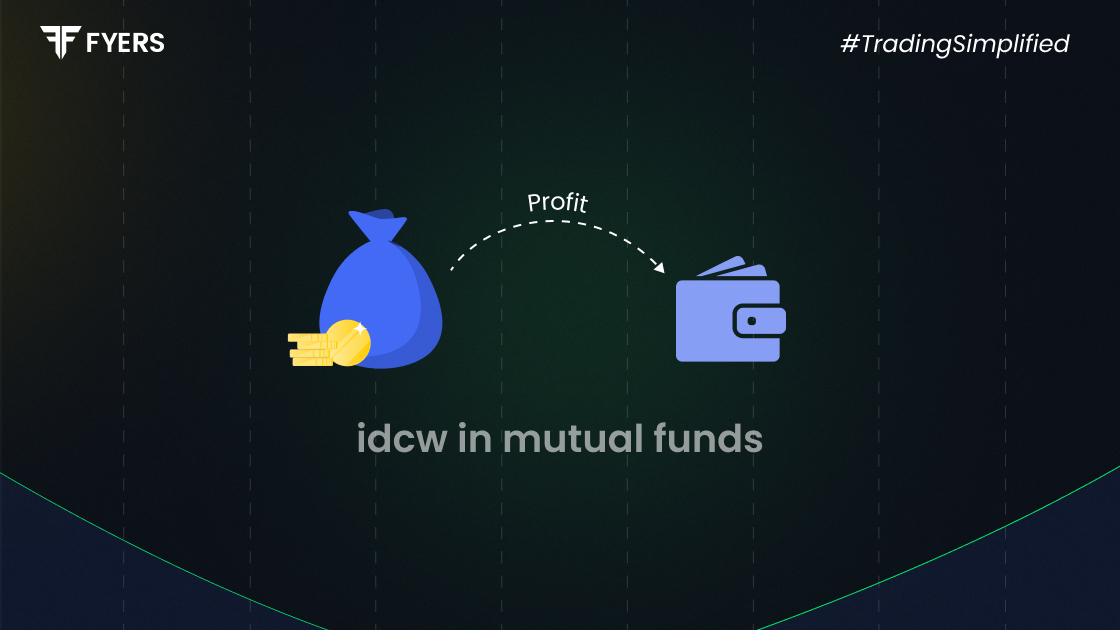

 7 Jul, 2025
7 Jul, 2025
 3 mins read
3 mins read

Mutual funds are a popular investment option in India, offering diverse schemes to suit various financial goals. One such feature is the IDCW in mutual funds, a concept that has evolved from what was earlier known as the dividend option. With new SEBI regulations, the term IDCW, or Income Distribution cum Capital Withdrawal, now better reflects how mutual funds distribute surplus income.
This blog will explain what is IDCW in mutual funds, how it works, its types, benefits, and the taxation rules that every investor should be aware of.
IDCW full form in mutual fund is Income Distribution cum Capital Withdrawal. It refers to periodic payouts made by a mutual fund scheme from its realised profits or surplus to investors. These payouts are not guaranteed and depend on the fund's performance.
SEBI introduced the term IDCW to replace the word ‘dividend’ to clarify that these distributions may come not just from income but also from capital. Hence, IDCW meaning in mutual funds reflects both income distribution and partial capital withdrawal, maintaining transparency.
To understand how IDCW works, consider the following process:
A mutual fund earns profit from its investments.
If the fund decides to distribute a portion of the profit, it declares an IDCW.
Investors receive this amount in proportion to the units they hold.
After the distribution, the fund’s NAV (Net Asset Value) is adjusted downwards.
Example:
If the NAV of a mutual fund is ₹100 and an IDCW of ₹2 is declared, the post-distribution NAV becomes ₹98. This ensures clarity and accountability in how returns are handled.
Mutual funds offer several IDCW options to suit different investor preferences:
IDCW - Regular Plan
Periodic payouts at set intervals (monthly, quarterly, or annually), suitable for those who want regular cash flows.
IDCW - Payout Option
The declared IDCW amount is credited directly to the investor’s bank account.
IDCW - Reinvestment Option
The IDCW amount is reinvested in the same scheme, and additional units are allocated to the investor.
IDCW - Transfer Option
IDCW income from one scheme is transferred to another mutual fund scheme of the same AMC, as per investor instructions.
Each option serves different needs - from income generation to reinvestment for long-term growth.
Choosing the IDCW option can be beneficial in specific scenarios:
Regular Income: Ideal for retirees or those needing supplementary income.
No Redemption Required: Investors don’t have to sell units to receive income.
Stay Invested: Enables continued participation in the fund’s market performance.
Flexible Payout Frequency: IDCWs can be received daily, monthly, quarterly, or annually, depending on the plan.
However, remember that IDCW payouts are not fixed and may vary based on market conditions and fund surplus.
With the shift in tax laws, the tax treatment of IDCW has changed significantly:
Taxable in Investor’s Hands: As of FY 2020–21, IDCW is added to your total income and taxed as per your income tax slab.
TDS Applicable: If the IDCW received in a financial year exceeds ₹5,000, 10% TDS (Tax Deducted at Source) is deducted.
No Capital Gains Benefit: Unlike the growth option, IDCW does not qualify for indexation or capital gains tax benefits.
For high-income investors, the growth option with SWP (Systematic Withdrawal Plan) may offer better tax efficiency compared to IDCW.
The IDCW in mutual funds provides an effective way for investors to receive periodic income without redeeming their units. It can be particularly useful for those looking for consistent cash flow, such as retirees or conservative investors. However, the payouts are market-linked and IDCW income is taxable, so it’s important to assess your needs, tax slab, and financial goals before choosing this option.
For long-term investors focused on wealth creation, the growth option might be more suitable due to tax efficiency and compounding benefits.
It stands for Income Distribution cum Capital Withdrawal. It refers to income distributions made from a fund’s surplus to investors, previously called dividends.
IDCW stands for Income Distribution cum Capital Withdrawal.
Earlier known as ‘dividend,’ SEBI renamed it as IDCW to clarify that distributions may include both income and capital components.
Yes, IDCW is added to your taxable income and taxed as per your income slab. TDS is also applicable if total IDCW exceeds ₹5,000 in a year.
Calculate your Net P&L after deducting all the charges like Tax, Brokerage, etc.
Find your required margin.
Calculate the average price you paid for a stock and determine your total cost.
Estimate your investment growth. Calculate potential returns on one-time investments.
Forecast your investment returns. Understand potential growth with regular contributions.